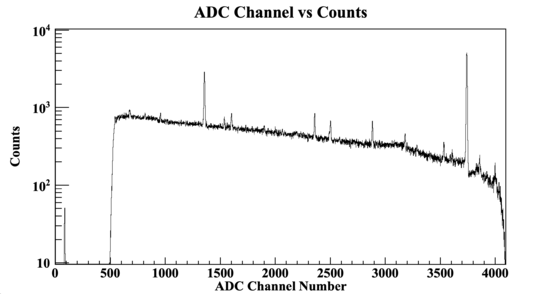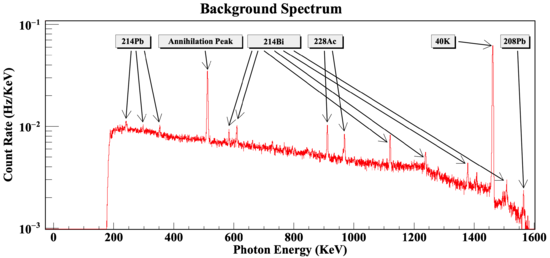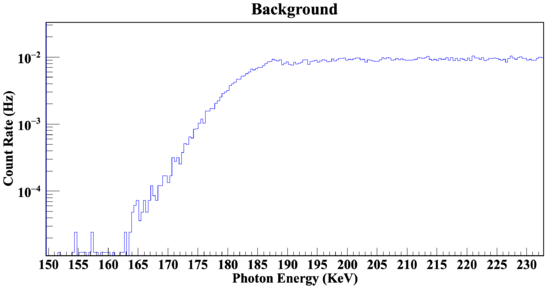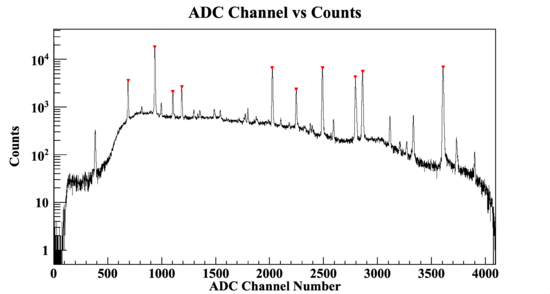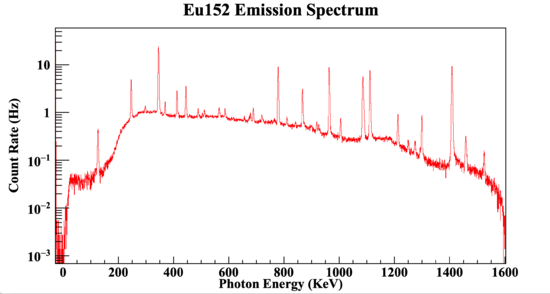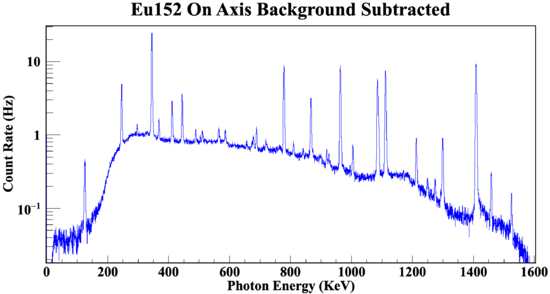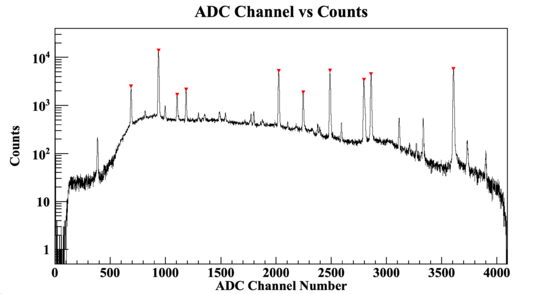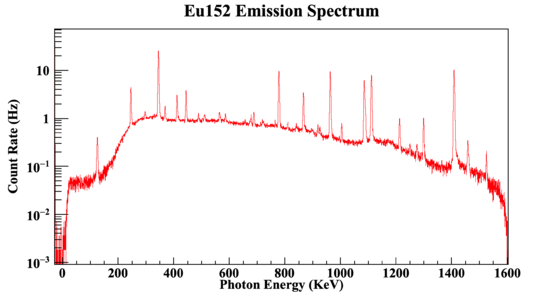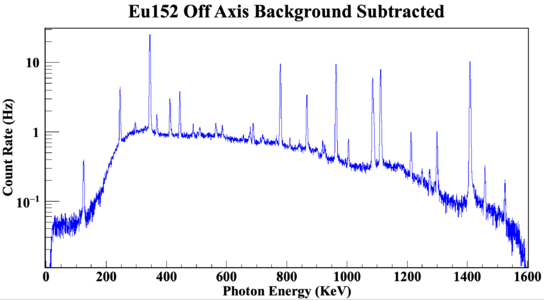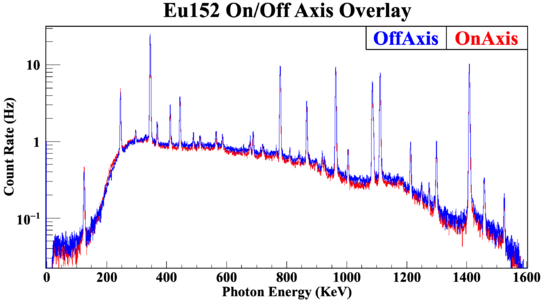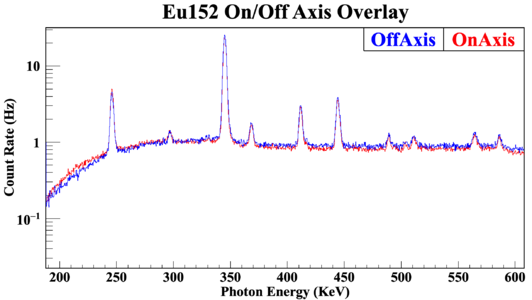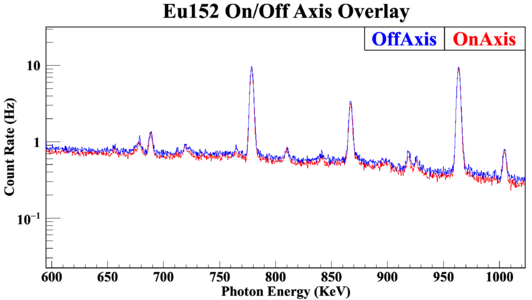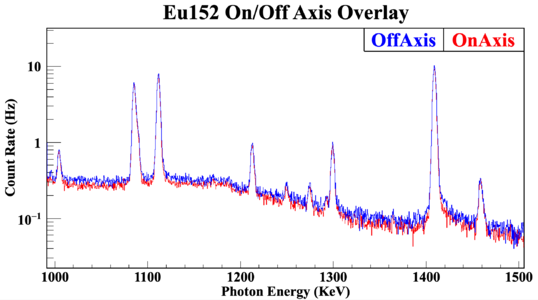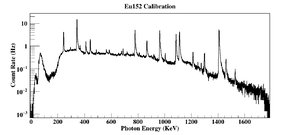Difference between revisions of "CH HPGe Efficiency"
| Line 131: | Line 131: | ||
==='''Photon Emission Rate'''=== | ==='''Photon Emission Rate'''=== | ||
| − | The radioactive source used in the irradiation experiments (on and off axis as defined above) | + | The radioactive source used in the irradiation experiments (on and off axis as defined above) was <sup>152</sup>Eu button source with an activity of ~37.7μCi on the day of irradiation. |
The activity of the source was converted from 37.7μCi to Becquerels using the conversion of 37,000<small><math>\frac{\text{Bq}}{\text{μCi}}</math></small>, yielding a decay rate for the <sup>152</sup>Eu source of ~1.3949•10<sup>6</sup> <small><math>\frac{\text{decays}}{\text{sec}}</math></small>. | The activity of the source was converted from 37.7μCi to Becquerels using the conversion of 37,000<small><math>\frac{\text{Bq}}{\text{μCi}}</math></small>, yielding a decay rate for the <sup>152</sup>Eu source of ~1.3949•10<sup>6</sup> <small><math>\frac{\text{decays}}{\text{sec}}</math></small>. | ||
Revision as of 20:58, 5 August 2022
Efficiency Measurements Summer 2022
Electronics Chain
Click here to view the electronics chain used for these efficiency measurements.
Experimental Setup
The Eu152 source provided by Roy Dunker was used to determine the efficiency and energy calibration for future experiments. As of 7/26/22, the Eu152 source had decayed to an activity of approximately 37.7μCi (~1.4•106 Bq).
Measurements
Energy Calibration
A linear regression was performed on the (ADC Channel Number, Peak Energy) data set. The data set is included in the table below.
| Index | ADC Channel Number | Eu152 Peak Energy (KeV) |
|---|---|---|
| 1 | 689 | 244.70 |
| 2 | 937 | 344.28 |
| 3 | 1105 | 411.12 |
| 4 | 1187 | 443.96 |
| 5 | 2025 | 778.90 |
| 6 | 2247 | 867.37 |
| 7 | 2490 | 964.08 |
| 8 | 2796 | 1085.9 |
| 9 | 2862 | 1112.1 |
| 10 | 3607 | 1408.0 |
The conversion from ADC Channel to KeV is as follows:
The KeV per bin can be found by taking the derivative of the energy conversion, leading to a constant 0.398 KeV per bin.
Background Spectrum
Run Parameters
| Date Performed | 7/27/22 - 7/28/22 |
| File Name | r7224.root |
| Run Time | 82129 Seconds |
| Count Rate | 24.97 Hz |
On Axis
Run Parameters
| Date Performed | 7/26/22 |
| File Name | r7222.root |
| Run Time | 726 Seconds |
| Count Rate | 2442.06 Hz |
90 Degrees Off Axis
Run Parameters
| Date Performed | 7/26/22 |
| File Name | r7223.root |
| Run Time | 542 Seconds |
| Count Rate | 2634.47 Hz |
Overlays
Calibration Source Measurements
Efficiency Calculations
Photon Emission Rate
The radioactive source used in the irradiation experiments (on and off axis as defined above) was 152Eu button source with an activity of ~37.7μCi on the day of irradiation.
The activity of the source was converted from 37.7μCi to Becquerels using the conversion of 37,000, yielding a decay rate for the 152Eu source of ~1.3949•106 .
The γ emission rate into 4π was found by totaling the intensities of photon lines produced via the EC and β- decay channels of 152Eu, for a result of 159.69%. Data sourced from IAEA Nuclear Data Section, decay radiation subsection for 152Eu.
Intrinsic Efficiency
Intrinsic efficiency as a function of energy is calculated by integrating the energy peak of interest and dividing by the number of photons crossing the detector plane at that energy. I used the method outlined below to calculate the intrinsic efficiency as a function of energy for the HPGe detector in the clean room.
Absolute Efficiency
Past Work
Most likely incorrect
Eu152 Calibration
- HPGe calibrated using Eu152 source
As of 9/28/21
The calibration used to map from ADC channel number to KeV is:
Where x = channel 9 of the ADC and is input as PADC.PADC785N[9].
Total Efficiency
This is total efficiency using the Gadolinium foil as the source.
For the ease of calculation, I will use the outgoing photon rate from the Gd foil as tabulated by MCNP, thanks to Paul Stonaha. The number given was into 2pi, towards the HPGe detector, multiplying by 2 should give the rate into 4pi.
The 897 KeV peak found in the Gd in/out measurements can be attributed to two different lines created by neutron capture on Gd157. The high purity germanium detector used in this experiment would not be able to resolve the two distinct lines as the resolution is not fine enough. However, adding the intensities together should yield the theoretical rate for the peak measured at that energy.
The first peak is 897.506 KeV with a relative intensity of 17.846%, according the capgam nndc data repository.
The second peak is 897.62 KeV with a relative intensity of 16%, according the capgam nndc data repository.
(0.17846 + 0.16) (2*1374Hz) (234000) = Rate
234000 is the total thermal neutron capture cross section for 157Gd
Note: the fudge factor comes from the nucleus being excited and then de-exciting from the neutron absorption and emits on average, 4 photons per neutron capture
Then find detected rate using HPGe
Divide (detected rate) by (theoretical rate) for total detector efficiency
An easier way to calculate the detector efficiency is
Theoretical total rate = 2748 Hz from simulations
| Line Energy | Line Weighting | Detected Rate | Detector Efficiency |
|---|---|---|---|
| 897 KeV (2 lines) | 0.03967382135 | 0.357 Hz | 0.33% 0.03 |
| 1107 KeV | 0.02885336857 | 0.264 Hz | 0.33% 0.03 |
| ~1186 KeV (2 lines) | 0.05145546699 | 0.511 Hz | 0.36% 0.03 |
